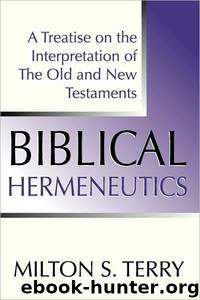Biblical Hermeneutics : A Treatise on the Interpretation of the Old and New Testaments by Milton Terry

Author:Milton Terry [Terry, Milton]
Language: eng
Format: epub
Tags: Christian Books & Bibles, Bible, More Translations, Bibles, Religion & Spirituality
Amazon: B00JVV2KGQ
Published: 2014-04-22T05:00:00+00:00
Every real correspondence should be noted. Thus, the lifting up of the brazen serpent, narrated in Num. xxi, 4-9, is one -j^g brazea of the most notable types of the Old Testament, and was serpent, explained by Jesus himself as a prefiguration of his being lifted up upon the cross (John iii, 14, 15). Three points of analogy are clear ly traceable: (1) As the brazen serpent was lifted up upon a pole, so Christ upon the cross. (2) As the serpent of brass was made, by divine order, in the likeness of the fiery serpents, so Christ was made in the likeness of sinful flesh (Rom. viii, 3) a curse for us (Gal. iii, 13). (3) As the offending Israelites, bitten and ready to die, looked unto the serpent of brass and lived, so sinful men, poi soned by the old serpent, the devil, and ready to perish, look by faith to the crucified Christ, and are made alive for evermore. Other incidental analogies involved in one or another of these three may be allowed, but should be used with caution. Thus, Bengel says: " As that serpent was one without venom placed over against venomous serpents, so the man Christ, a man without sin, against the old serpent." l This thought may be incidentally included in anal ogy (2) above. Lange's observation, however, seems too far-fetched and mystical: "The fiery serpents in the wilderness were primarily the form of a divine punishment, presented in a form elsewhere de noting sin. The elevated serpent-standard was thus the type of punishment lifted in the phantom of sin, and transformed into a means of salvation. This is the nature of the cross. The look at the cross is a look at the curse-laden One, who is not a sinner, but a divine token of evil and penalty, and of the suffering of [a sub stitute for] penalty which is holy, and therefore transformed into deliverance."" Such incidental analogies, as long as they adhere consistently to the main points, may be allowed, especially in homi-letical discourse. But to find in the brass—a metal inferior to gold or silver—a type of the outward meanness of the Saviour's appear ance; or to suppose that it was cast in a mould, not wrought by hand, and thus typified the divine conception of Christ's human nature; or to imagine that it was fashioned in the shape of a cross to depict more exactly the form in which Christ was to suffer— these, and all like suppositions, are far-fetched, misleading, and to be rejected.
In Hebrews vii the priesthood of Christ is illustrated and en hanced by typical analogies in the character and position Melchizedek of Melchizedek. Four points of resemblance are there and Christ, set forth. (1) Melchizedek was both king and priest; so Christ. (2) His timelessness—being without recorded parentage, genealogy, 1 Gnomon, on John iii, 14. 8 Commentary on John, in loco.
Download
This site does not store any files on its server. We only index and link to content provided by other sites. Please contact the content providers to delete copyright contents if any and email us, we'll remove relevant links or contents immediately.
| Exegesis & Hermeneutics | New Testament |
| Old Testament |
The Five People You Meet in Heaven by Mitch Albom(3474)
The Secret Power of Speaking God's Word by Joyce Meyer(2971)
Real Sex by Lauren F. Winner(2967)
Name Book, The: Over 10,000 Names--Their Meanings, Origins, and Spiritual Significance by Astoria Dorothy(2939)
The Holy Spirit by Billy Graham(2892)
0041152001443424520 .pdf by Unknown(2784)
ESV Study Bible by Crossway(2732)
How The Mind Works by Steven Pinker(2729)
Ancient Worlds by Michael Scott(2623)
Churchill by Paul Johnson(2506)
The Meaning of the Library by unknow(2505)
The ESV Study Bible by Crossway Bibles(2502)
The Gnostic Gospels by Pagels Elaine(2470)
MOSES THE EGYPTIAN by Jan Assmann(2372)
Jesus by Paul Johnson(2310)
City of Stairs by Robert Jackson Bennett(2307)
The Complete Dead Sea Scrolls in English (7th Edition) (Penguin Classics) by Geza Vermes(2234)
Ancient Near Eastern Thought and the Old Testament by John H. Walton(2196)
The Nativity by Geza Vermes(2180)
